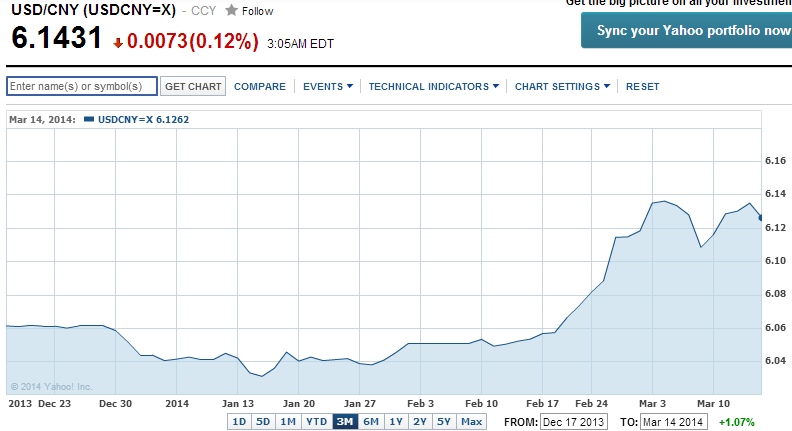The People’s Bank of China (PBOC) has made good on its promise to widen the trading band on the Yuan (CNY) this past weekend. They doubled the band. On Monday, Yuan continued its trend lower.
On Saturday, the PBOC announced they would widen the band for their currency from +/-1 percent to two percent. This means the currency will fluctuate two percent above or under the midpoint fixed by the bank. As you can see in the chart below, USD/CNY weakened even further and continues its downtrend capital flowing in and out of the country along with sentiment in China weakens.

As China’s economy continues to weaken further over the next months, the cost of capital should weaken as well. This means the exchange rate is likely to weaken further and volatility is likely to increase. Exchange rates are often set by short term cash flows in and out of a country. Export growth, should also benefit from a weaker currency. Domestic demand, like investments, along with reform initiatives should help the economy in the long term. It will not be surprising if the USD/CNY breaks below $6 some point in 2014.
This Move was Priced In
The move to widen the trading ban was expected with any change in the USD/CNY priced in. This is evident as the Yuan broke off its steady bullish trend and began falling. It has lost nearly two percent since the beginning of February. This weakening was a demonstration from policy makers who are ready to be more relaxed to freeing the currency up to market pressures. One step closer to a free floating currency. By allowing the Yuan to weaken, policy makers sent a message to speculators who thought the currency was a one way bet. They also sent a signal that they are confident in China’s ability to withstand and survive any policy reforms they PBOC and government are going to allow.
We should see the currency fall sharply this year as money moves out of China. For the year, we could see it depreciate another 6 to 6.5 percent.
This is not a Bad thing For China’s Economy
This is due to money invested in China finding new asset classes to invest in. As the exchange price with the Yuan decreases, the export industry in China is likely to benefit. We have seen exports, for February, falling to their lowest levels since the global financial crisis. However, this move is not beneficial with helping China rebalance from an export and investment economy to one that is consumption driven.
This is a positive move for China a step in the right direction. We should be cautious as it is unlikely the PBOC will continue to relax its grip on the currency if it falls off sharply. The last time the bank widened the band was back in April of 2012. The Yuan weakened at first then strengthened. After its initial dip, it rose almost five percent versus the U.S. Dollar. The big change from last time, is sentiment. More and more analysts consider the sentiment more bearish and are bracing themselves for China to fall below their target 7.5 percent growth this year.
Binary Option Take for the Day
We should see volatility in the Yuan. Its steady rise higher or lower is no longer a sure bet which makes investors more and more eager to trade this currency. The question remains how much the PBOC is willing to allow market forces to dictate exchange price. Right now, sentiment is bearish.
Discussion:
Is the PBOC finally keeping its promise to reform its policy on the Yuan? While a step in the right direction, the Chinese Currency is far from being market driven or allowed to float freely. What is your take? Do you think the PBOC will relax its grip even more over the next year?
